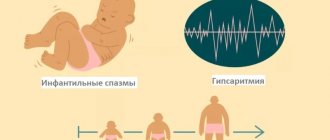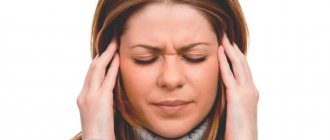TREATMENT FOR TOURETTE SYNDROME IS AVAILABLE IN THE BRANCHES:
Treatment of Tourette's syndrome in the Primorsky region
Address: St. Petersburg , Primorsky district, st. Repisheva, 13
Treatment of Tourette's syndrome in the Petrograd region
Address: St. Petersburg , Petrogradsky district, st. Lenina, 5
Treatment of Tourette's syndrome in the Krasnogvardeysky district
Address: St. Petersburg , Krasnogvardeisky district, Novocherkassky pr., 33 building 3
Treatment of Tourette's syndrome in Vsevolozhsk
Address: Vsevolozhsk , Oktyabrsky Prospekt, 96 A
Course and prognosis of Tourette's syndrome
When treated for Tourette's syndrome, half of patients experience improvement or stabilization in late adolescence or adulthood. If persistent generalized tics persist and cannot be controlled, lifelong drug therapy is required.
Despite its chronic course, Tourette syndrome does not affect life expectancy, but can significantly worsen its quality. Patients with Tourette syndrome are prone to depression, panic attacks, and antisocial behavior, and therefore need understanding and psychological support from others.
This syndrome should not negatively affect your life. There are many people known to suppress its symptoms. For example, the now mega-popular singer Billie Eilish, who has been diagnosed with Tourette syndrome, shows that it is quite possible to live with this.
Tim Howard also serves as an excellent example that this disorder is not a death sentence. For those who don't know, this is an American goalkeeper. Moreover, the goalkeeper is not bad. He played for Manchester United and Everton, and was also a goalkeeper for the US national football team. And everywhere he acted as the main goalkeeper.
Causes and risk factors
Treatment for Tourette's is complicated by the fact that it is a genetic disorder, meaning complete recovery is not possible. Fortunately, modern medications and therapeutic techniques make it possible to almost completely relieve symptoms and give the patient a chance to live a full life in society.
Modern treatment of Tourette syndrome is based on the fact that this disease causes not one mutation in a specific gene, but several disorders at once, so it is customary to talk about the architecture of the disease. Various mutations in the genome affect how the disease manifests itself.
Additional risk factors that can provoke symptoms of the disease and lead to the need to prescribe Tourette's treatment include:
- traumatic brain injuries;
- stressful situations (fear, going to kindergarten or school, watching a scary movie);
- mental overload;
- infections (streptococcal, respiratory viral);
- long sessions on the computer.
All these events can trigger the disease if a person has mutations in the genome. According to statistics, the probability of hereditary transmission of the disease is 60%, which means that if a parent needed Tourette's treatment, then in 6 out of 10 cases his children will also need it.
Service price
- Basic services Consultative appointment with a doctor (including a candidate of medical sciences, adults and children)3,000
Identification and treatment of Tourette's syndrome and other hyperkinesis. Consultative assistance, inpatient treatment. A combination of medication, psychotherapy and physical therapy. We help children, teenagers and adults. We work around the clock.
Tourette's syndrome
- a disease of the nervous system, manifested by involuntary and abnormal muscle contractions (motor tics) and shouting of sounds or phrases (audio tics).
Tourette's syndrome: symptoms
Treatment of Gilles de la Tourette syndrome must begin with identifying the symptoms. After all, the course of treatment depends on their type and frequency of manifestation. Symptoms include the following conditions:
- motor tics. Uncontrollable movements of a group of muscles, usually the face and head;
- vocal tics. Pronouncing strange sounds, words, obscene expressions.
There is a classification of symptoms according to various criteria:
- etiology. Primary or hereditary, secondary (medicinal and symptomatic), cryptogenic (without established causes);
- topical clinical manifestation. Local (only one muscle group), widespread (more than two muscle groups), generalized in combination with vocal tics, infantile benign form;
- severity (calculated over an observation period of 20 minutes). Single (less than a dozen manifestations), serial (up to 30), status (over 30). The total number of all types of tics is determined, and the ratio of motor and vocal ones is also recorded;
- flow. Transient (Tourette's treatment takes up to 3 years and leads to complete reversibility of hyperkinesis), remitting (single manifestations or complete regression), stationary, progressive increase in symptoms (drug resistance, no remission);
- stages. Debut (3-7 years), intensification of symptoms (8-12 years), residual – persistence of manifested symptoms (13-15 years).
In addition, treatment of Tourette's disease may be accompanied by the following manifestations:
- Coprolalia – spontaneous utterance of prohibited words or phrases. Most often occurs in adolescence, but is replaced by other symptoms over time;
- copropraxia - unacceptable gestures;
- echolalia - mimicking, repeating words that other people say;
- palilalia – constant repetition of one’s own word;
- echopraxia - imitation of someone else's movements.
However, most of these manifestations are quite rare, and the main symptoms for which Tourette's treatment is prescribed are motor and vocal tics. Immediately before their onset, the patient, as a rule, experiences strong arousal, which they themselves characterize as increasing tension, discomfort that needs to be alleviated and released.
Classification of Tourette's syndrome
Tics are sudden, repetitive, irregular movements (motor tics) caused by the contraction of individual muscle groups. Motor tics are based on movement, while speech tics involve the involuntary production of sounds through the nose, mouth or throat.
The DSM-IV-TR classified Tourette Syndrome as one of several tic disorders that "often manifest in infancy, childhood, or adolescence" and are categorized by type (motor or vocal tics) and duration (temporary or chronic). Temporary tics manifest as multiple motor or vocal tics (sometimes both) over a period of four weeks to twelve months. Chronic tics can be single or multiple, motor or auditory (but never both), which appear for more than a year.
Tourette syndrome can be diagnosed if there are constant motor tics and at least one vocal tic for a year. The DSM-5, published in May 2013, reclassified Tourette syndrome and tic disorders as movement disorders classified as neurodevelopmental disorders, and replaced transient tics with temporary tics. In addition, several other significant changes have been made.
Tourette syndrome is classified in almost the same way in ICD-10, which was compiled by the World Health Organization. In this classification, multiple auditory and motor tics (Tourette's syndrome) were coded F95.2. Although Tourette's is the most severe of all tic disorders, most cases of the disease are fairly mild. Symptoms of patients vary greatly and a moderate form of the disease may not be noticed at all.
Treatment of Tourette's syndrome in children
Treatment of Tourette's syndrome at an early age requires attentiveness and courtesy on the part of the doctor. Symptoms of the disease often affect the child’s relationships with others, which negatively affects his psychological development.
Tourette's treatment in childhood and adolescence is carried out in three ways:
- behavioral psychotherapy. The main task is to teach the child to correctly perceive his illness. His self-esteem rises, work is done to eliminate the feeling of inferiority. This is done using meditative techniques, which reduce the frequency of tics, and in some cases even prevent their occurrence. Treatment of Tourette syndrome in Russia is new, but is already showing good results;
- play therapy. Specially designed games, creative activities, and art therapy help improve the mental state of the little patient. Through play, the child’s social adaptation is carried out, which helps to avoid the appearance of additional psychological problems (depression, isolation, anxiety). Tourette's treatment in combination with playing wind instruments and moderate sports shows positive dynamics;
- drug treatment. It is used only in exceptional cases when an acute condition occurs or other mental disorders appear. However, such conditions occur extremely rarely, so such potent medications, especially at an early age, are prescribed in exceptional cases.
Stages of Tourette's syndrome
Patients are diagnosed in 4 stages:
- Light. In this case, the syndrome may be invisible even to loved ones. A person is in complete control of his behavior. Tics may not be observed for a long time.
- Moderate. Sometimes emotional stress increases so much that the patient cannot control the attack.
- Expressed. During attacks, a person with this stage almost completely loses control. It is difficult for him to live in society. It becomes almost impossible to work and solve everyday problems.
- Heavy. The attacks are uncontrollable. Such patients are often diagnosed with incapacity.
Modern diagnostic methods do not guarantee 100% detection of the disease. Doctors often make this diagnosis if, in addition to external manifestations, the patient had family members with similar problems.
Diagnosis of the disease
Treatment for Tourette syndrome is prescribed exclusively by a doctor. The diagnosis is made based on the medical history and symptoms. Unfortunately, there is no universal test for diagnosing the disease, so in some cases an electroencephalogram (EEG) or computed tomography may be prescribed. It is also necessary to take a blood test to rule out other diseases.
In addition, since a number of other diseases may be associated with this syndrome, additional research may be required. The most common tests are for attention deficit hyperactivity disorder, depression, and obsessive-compulsive disorder.
Diagnosis of Tourette's disease
Diagnosis of Tourette's disease is based on collecting anamnesis (presence of relatives with this disease), characteristic symptoms that have been present for a year or more.
At the first visit of a patient with Tourette's syndrome, a neurological examination is performed, the purpose of which is to exclude organic brain damage (tumor). To do this, the patient undergoes computed tomography, nuclear magnetic resonance and electroencephalography. A biochemical blood test is also examined to exclude metabolic disorders.
Differential diagnosis is carried out with many diseases (Wilson-Konovalov disease, Huntington's chorea, juvenile form of Parkinson's disease, rheumatic chorea and others).
Tourette treatment in St. Petersburg
Medical is a network of modern clinics in three districts of St. Petersburg and the city of Vsevolozhsk. Treatment of Gilles de la Tourette is one of the areas of our work, for which all the necessary conditions have been created.
Medical is:
- more than 40 psychiatrists and other specialties. With us, the patient receives a comprehensive examination and consultation from any highly specialized specialist;
- own hospital. In some cases, it is simply necessary for the patient to be under the supervision of a doctor around the clock. Comfortable rooms, attentive staff and a calm environment - all this contributes to a speedy recovery;
- high-quality diagnostics. Ultrasound, electroencephalogram, neurophysiological analysis of conceptual functions, test psychodiagnostics and much more;
- In the treatment of mental illness, we have the right to prescribe the full range of potent drugs. In St. Petersburg, only a few private clinics have such a privilege.
Medical Center Code
- effective drugs and necessary treatment. In our case, to inflate the bill - only those treatments, those procedures and those drugs that are really necessary for effective treatment;
- exceptional confidentiality. Under no circumstances will client information be disclosed to third parties;
- soft impact. No use of force or forced treatment. Delicacy and the power of persuasion are our helpers.
Causes of Tourette's syndrome
The specific reasons why Gilles de la Tourette syndrome appears have not been established, however, genes as well as some environmental factors may be the causes. According to several studies, genes play an important role:
- Genetic studies show that Tourette syndrome is inherited by a dominant gene with a 50% chance of being passed on to children.
- Boys are three to four times more likely to get this gene.
- Tourette's syndrome can be caused by abnormal metabolism.
Research also suggests that it may be the result of the interaction of several genes and other environmental factors. Some environmental risk factors that may contribute to Tourette's syndrome have been identified, however, much research still needs to be done. Here are some of these factors:
- Alcohol or tobacco abuse during pregnancy
- Complications of childbirth
- Low birth weight
- Infections
Cost of treatment for Tourette syndrome:
| Services list | Price in rubles | |
| Saint Petersburg | Vsevolozhsk | |
| Consultation with a psychologist | from 2500 | from 2500 |
| Psychiatrist consultation | from 3500 | from 3000 |
| Consultation with a psychotherapist | from 3500 | from 4000 |
| Consultation with a sexologist | 4500 | 4500 |
| Consultation with a narcologist | from 3000 | from 3500 |
| Family psychotherapy session | from 3500 | from 3500 |
| Group psychotherapy session | 1800 | — |
| Psychotherapeutic consultation | 11000 | 11000 |
| Full psychodiagnostic examination (2 hours) | 6000-7000 | 6000-7000 |
| Wechsler test | 5000 | — |
| Psychiatrist's report for reference | 1000 | 1000 |
| Psychiatric examination before the transaction | 7000 | 7000 |
| PSYCHIATRIC HOSPITAL | ||
| Standard (4-seater) | — | 5500 |
| Standard+ (2-seater) | — | 7000 |
| Junior Suite (2-bed) | — | 7800 |
| Luxury (2-bed) | — | 8500 |
| Premium (1-seater) | — | 10000 |
The prices indicated on the website are not a public offer. Check the cost with the administrators.
Symptoms of Tourette's syndrome
Most often, the first symptoms of Tourette's syndrome manifest in a child aged 5 to 6 years.
In general, the signs and symptoms of Tourette syndrome are:
- Parents begin to notice certain oddities in their children's behavior. Children make grimaces, stick out their tongues, wink, blink frequently, clap their hands, etc.
- As the disease progresses, the muscles of the trunk and legs become involved. Hyperkinesis becomes more complex and begins to manifest itself in jumping, throwing out the lower limbs, and squats.
- From an early age, children are capricious, restless, inattentive, and very vulnerable. Due to such high emotionality, it is difficult for them to establish contact with peers.
- Patients are prone to depression and increased irritability. Depressive disorders are replaced by attacks of rage and aggression. After a short time, aggressive behavior is replaced by a cheerful and energetic mood. The patient becomes active and at ease.
- Echopraxia and cypropraxia are often observed. The former are expressed in copying the movements of other people, and the latter in offensive gestures.
- Tics can pose a certain danger, since patients are able to hit their heads, put pressure on their eyes, bite their lips hard, etc. As a result, patients independently inflict quite serious injuries on themselves.
- Vocal tics or, as they are also called, vocal tics are very diverse in Tourette syndrome. They are expressed in the repetition of meaningless sounds and words, in whistling, puffing, mooing, hissing, and screaming. When vocal tics are introduced into the process of a person’s monologue, the illusion of stuttering, hesitation and other problems with the patient’s speech is created.
- Sometimes patients cough non-stop and sniffle. Similar manifestations of Tourette's syndrome can be mistaken for symptoms of other diseases, for example, rhinitis, tracheitis, sinusitis, etc.
Patients are also characterized by speech disorders such as:
- Coprolalia - uttering obscene words (is not
- A pathognomonic symptom, as it is observed only in 10% of cases);
- Echolalia - repetitions of phrases and words spoken by the interlocutor;
- Palilalia are repeated repetitions of the same word.
- The speed of speech, its timbre, volume, tone, accents, etc. may change.
- If boys are characterized by coprolalia, then girls are characterized by obsessive-compulsive traits. Coprolalia is a serious symptom of the disease, as it contributes to social maladjustment. A person pronounces curses loudly, sometimes even shouts. Phrases are abrupt.
- The patient's behavior during an attack can be very eccentric. They can grunt, crack their fingers, sway from side to side, rotate around their axis, etc.
- Patients are able to anticipate the onset of the next attack, as it is accompanied by the appearance of a certain aura. There may be a lump in the throat, pain in the eyes, itchy skin, etc. As patients explain, it is these subjective sensations that force them to reproduce this or that sound or phrase. The tension goes away immediately after the tick is completed. The stronger the patient’s emotional experiences, the more frequent and intense the tics will be, both vocal and motor.
- The intellectual development of patients does not suffer. But motor and speech tics affect his learning and behavior.
- Other symptoms of Tourette's syndrome are behavioral reactions expressed in excessive impulsiveness, aggression, and emotional instability.
- The disease reaches its peak in adolescence, and as maturity approaches, it declines or disappears altogether. However, it is possible that symptoms of the disease will persist throughout a person’s life. In 25% of cases, the disease proceeds latently and worsens after a few years. Complete remission is rare.
Depending on how severe the symptoms of the disease are in the patient, there are several degrees of Tourette syndrome:
- Mild degree. The patient is able to control all vocal and motor abnormalities without problems. Sometimes these disorders remain unrecognized by people around them. In addition, symptom-free periods are possible, although these are quite short-lived.
- Moderate degree. The patient is able to control the existing disorders, but it is not possible to hide them from the environment. In this case, there are no asymptomatic periods at all.
- Pronounced degree. A person is unable to control the symptoms of the disease, or does so with great difficulty. Signs of the disease are obvious to everyone around.
- Severe degree. Vocal tics and motor tics are pronounced. The muscles of the trunk and limbs are involved in the process. A person is unable to control the symptoms of the disease.
Features of tics in Tourette syndrome
Tics in Tourette syndrome have characteristic features. Thus, movement disorders are always monotonous, and the patient can suppress them for a while. There is no rhythm.
Another distinctive feature of tics is that they are preceded by an impulse that a person is unable to overcome. It occurs immediately before the start of the tic. Patients describe it as increased tension, increased feelings of pressure, or increased energy that needs to be released. This must be done in order to normalize your condition, to return to your previous “good” state of health.
Patients indicate that they feel a lump in their throat and discomfort in the shoulder girdle. This prompts them to shrug their shoulders or clear their throat. In order to get rid of the unpleasant sensation in the eyes, people begin to blink frequently. Prodromal sensory phenomena, or prodromal urges, are the names of these urges that patients experience before tics.
However, not every patient, especially in childhood, is able to appreciate this foreboding urge. Sometimes children do not even notice that they have tics and are surprised if they are asked a question about this or that condition.
Reasons for appearance
It is not known exactly why Tourette syndrome occurs. Today it is associated with heredity - the disease often appears in close relatives. However, it has not yet been established which gene is responsible for the appearance of the syndrome. It is believed that external factors may also influence the risk of developing the disease, but the specific causes or conditions for the occurrence of tic disorders have not been identified.
There are a number of factors that influence the severity of symptoms. Among them:
- intoxication;
- increased body temperature;
- past streptococcal infection;
- taking psychostimulants in childhood (with attention deficit disorder, with emotional stress).
Tourette's syndrome is not uncommon. For example, in the United States, every 160 children aged 5 to 17 years suffer from it.
There are several disorders associated with Tourette syndrome (the disease appears against their background or is accompanied by them):
- attention deficit hyperactivity disorder (ADHD);
- obsessive-compulsive disorder (repetitive obsessive behavior or thoughts);
- behavioral problems: anger, aggression, disobedience, socially unacceptable behavior;
- separation anxiety;
- poor learning ability;
- difficulties with social interaction;
- sleep disorders;
- sensory disturbances, such as hypersensitivity.
Treatment of Tourette's disease at Sarklinik
Based on the results of the work of Sarklinik (Saratov, Russia), it was established that complex differentiated treatment of patients with de la Tourette’s disease with the widespread use of new reflexology techniques allows one to achieve satisfactory results even with pronounced hyperkinesis and vocalisms. Thus, out of 704 patients with Tourette's syndrome aged from 3 to 47 years with varying degrees of severity of clinical manifestations, after repeated courses of restorative treatment, hyperkinesis and vocal disorders disappeared in 571 patients (81.1%).
Severity of Tourette's syndrome
Neurologists, neuropathologists, neuropsychiatrists, psychiatrists, and reflexologists distinguish 4 degrees of severity of the main clinical manifestations of Tourette's disease.
Mild degree
1st degree (mild) Tourette's. At this degree, the external manifestations of the disease are often invisible, and patients control them quite well in society. For a short period of time, these signs of the disease may be absent.
Moderate degree
2nd degree (moderate) Tourette's. It is characterized by the presence of hyperkinesis and vocal disturbances that are quite obvious to others. Some ability of self-control is retained. There is no asymptomatic period.
Expressed degree
3rd degree (severe) Tourette's. At this level, patients in a group can hardly and briefly control the symptoms of the disease, which in all cases are clearly presented.
Severe degree
4th degree (severe) Tourette's. It is characterized by the presence of pronounced signs of the disease, almost uncontrollable.
Extremely severe
Grade 5 (extremely severe) Tourette's. Pronounced clinical manifestations with many motor and vocal tics, the presence of pronounced coprolalia.
Can Tourette's syndrome be treated?
Parents of children and adolescents often ask doctors: “ Can Tourette syndrome be treated ?” And the question is clear. After all, many methods of therapy and medications that they used either do not help, or have a weak positive effect. Sarklinik answers. Tourette's syndrome is treatable. Yes, he is being treated hard and for a long time, but he is being treated. The most important thing is that each patient is given the treatment that will help him. After achieving a positive result, it is necessary to periodically do maintenance courses of therapy.
Treatment information:
Vocal Tic Therapy
Therapy for echolalia
Sign up for a consultation. There are contraindications. Specialist consultation is required.
Photo: Paha_l | Dreamstime.com\Dreamstock.ru. The people depicted in the photo are models, do not suffer from the diseases described and/or all similarities are excluded.
Related posts:
Bruxism, teeth grinding during sleep, odonterism: symptoms and treatment
Sleepwalking in children, adults, treatment, somnambulism, sleepwalking
Sound, vocal tics in children: treatment, symptoms; adult tics
Speech aphasia in children, afrasia in children and adults
Enuresis, treatment of enuresis, how to treat nocturnal enuresis in Saratov, Russia








